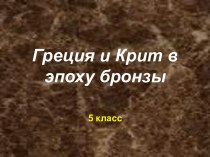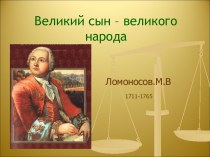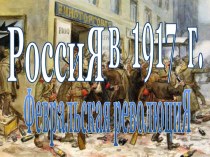- Главная
- Разное
- Бизнес и предпринимательство
- Образование
- Развлечения
- Государство
- Спорт
- Графика
- Культурология
- Еда и кулинария
- Лингвистика
- Религиоведение
- Черчение
- Физкультура
- ИЗО
- Психология
- Социология
- Английский язык
- Астрономия
- Алгебра
- Биология
- География
- Геометрия
- Детские презентации
- Информатика
- История
- Литература
- Маркетинг
- Математика
- Медицина
- Менеджмент
- Музыка
- МХК
- Немецкий язык
- ОБЖ
- Обществознание
- Окружающий мир
- Педагогика
- Русский язык
- Технология
- Физика
- Философия
- Химия
- Шаблоны, картинки для презентаций
- Экология
- Экономика
- Юриспруденция
Что такое findslide.org?
FindSlide.org - это сайт презентаций, докладов, шаблонов в формате PowerPoint.
Обратная связь
Email: Нажмите что бы посмотреть
Презентация на тему The comintern and the Western Communist Parties 1930-1949
Содержание
- 2. The comintern and the Western
- 3. The « Great Terror »THE GREAT PURGES OF THE
- 4. Debate in the West about the precise
- 5. The « Gullags »THE PENAL SYSTEM ADMINISTERED
- 6. We find also a system of labor
- 7. The « Great Terror »: The Moscow trialsIn March
- 8. Like a three-ring circus, each trial
- 11. The Great Terror followed the tremendous increase
- 12. The « Great Terror »The Great Terror of 1937-1938
- 13. All major countries (Germany, Poland, Japan, Britain,
- 14. Most if not all those repressed as
- 15. In August 1931, Stalin urged M.M. Litvinov,
- 16. Stalin wrote in 1945:“The defeat of the
- 17. In order to carry out the Polish
- 18. Stalin also often praised Poland as a
- 19. Before Adolf Hitler’s ascension to power, Poland
- 20. In 1923 Japan invited the Polish specialist
- 21. Much of Poland’s anti-Soviet intelligence was carried
- 22. This sort of caution was sensible, given
- 23. A few months later, he reported that
- 24. In early July 1926, Дзержинский wrote to
- 25. An example: Jerzy Niezbrzycki (Ryszard Wraga), a
- 26. One of the most important strategic goals
- 27. The most important group for the “Promethean
- 28. In May of that year, according to
- 29. According to Soviet data, between 1922 and
- 30. Likewise, many Ukrainian émigré organizations in Poland
- 31. By the mid-1930s, like ethnic Germans, ethnic
- 32. Like other countries, Japan used its diplomatic
- 33. Like Poland, Japan showed keen interest in
- 34. Japan and Poland had common political and
- 35. After the Polish-German non-aggression pact signed in
- 36. Meanwhile, the NKVD, now headed by Nikolai
- 37. Alexander Orlov, a former NKVD official noted
- 38. The Great Terror was a precautionary strike
- 39. In October 1938, when he was ending
- 40. The Stalinist violence of the years 1937-1938
- 41. According to Stalin, the critical state of
- 42. On July 30, 1937, the Secret Police
- 43. Anti-Soviet elements that actively collaborated with religious-
- 44. The second largest purge was named “national
- 45. On July 20, 1937, Stalin notified the
- 46. Komintern and the PurgesAccording to Stalin’s
- 47. “Letter from Dimitrov and D.Z. Manuilsky to
- 48. In the past, the Comintern's apparatus was
- 49. Conclusion:The fear of a new foreign invasion,
- 50. The international situation appeared only to got
- 51. Скачать презентацию
- 52. Похожие презентации
The comintern and the Western Communist Parties 1930-1949 Dr. Nikolaos Papadatos- University of Geneva









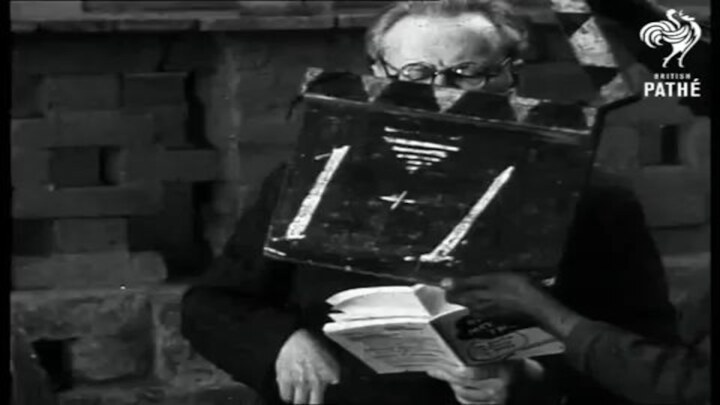




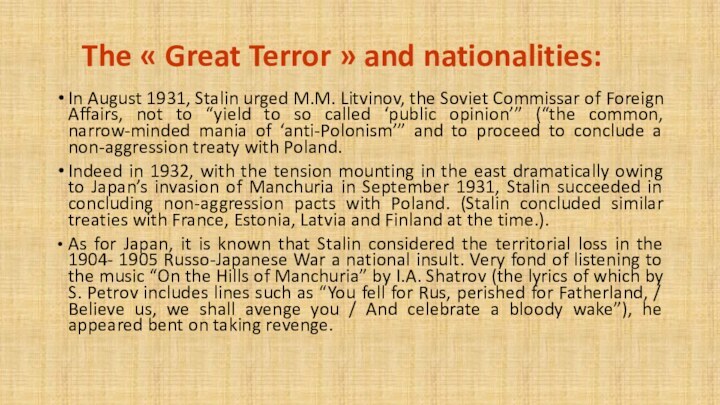

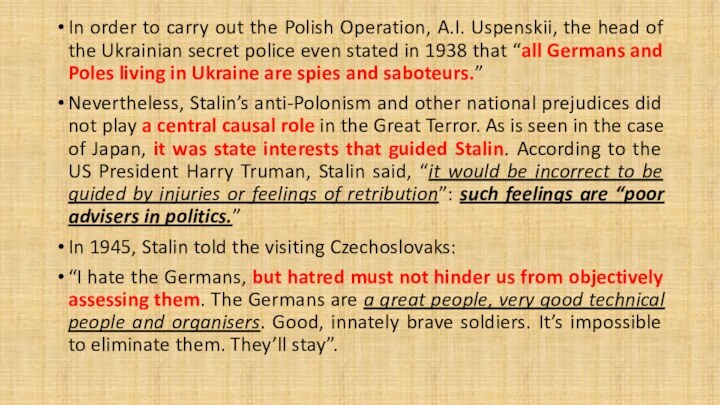


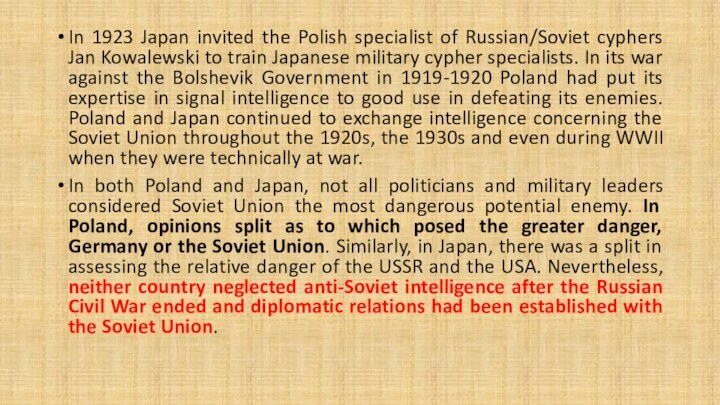


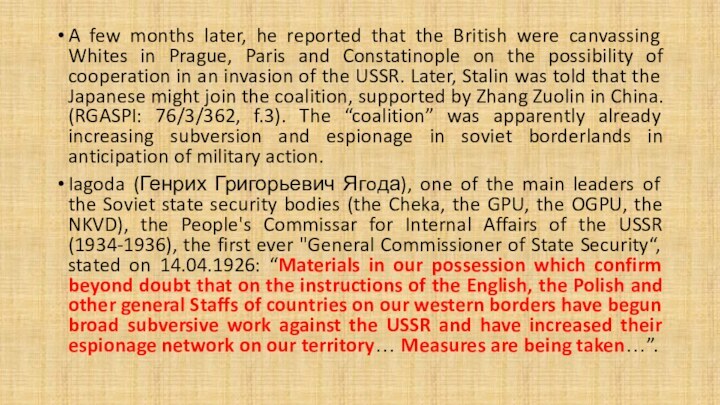


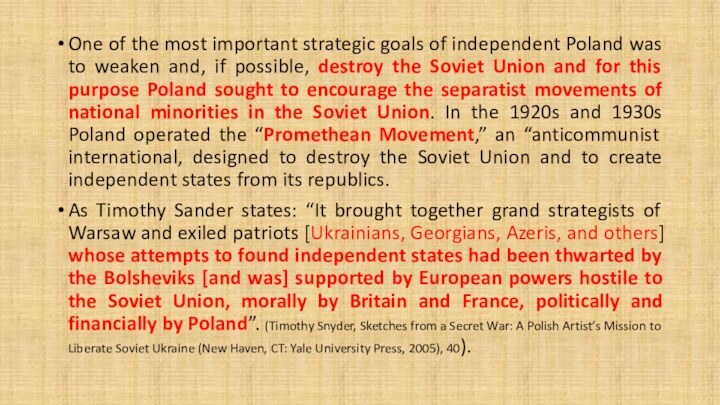


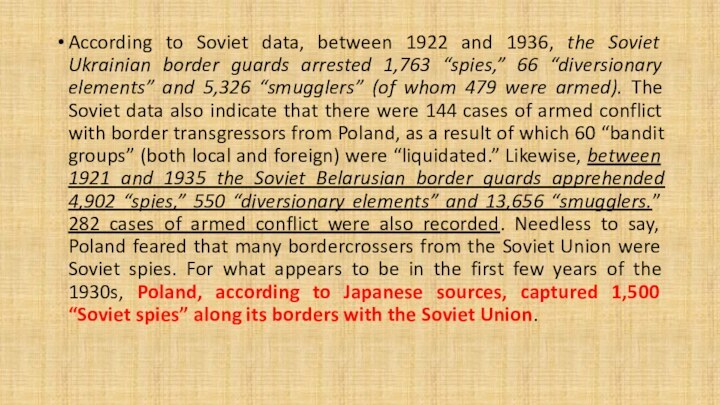





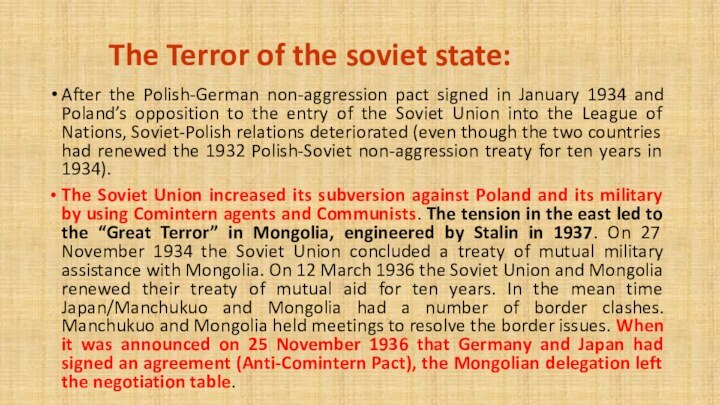

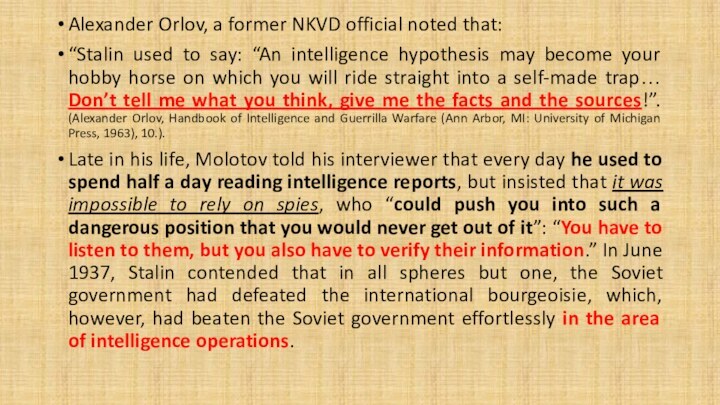


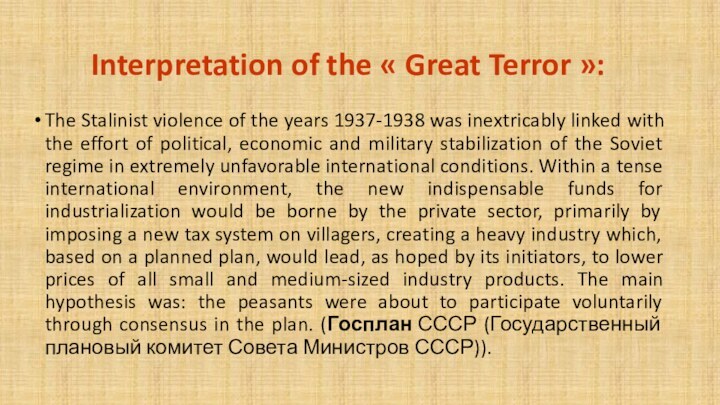
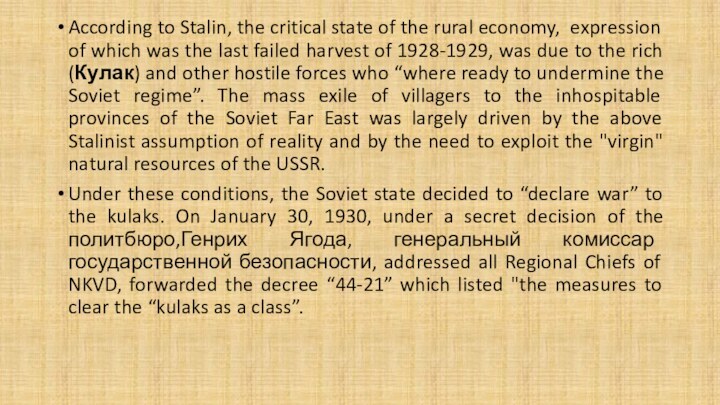







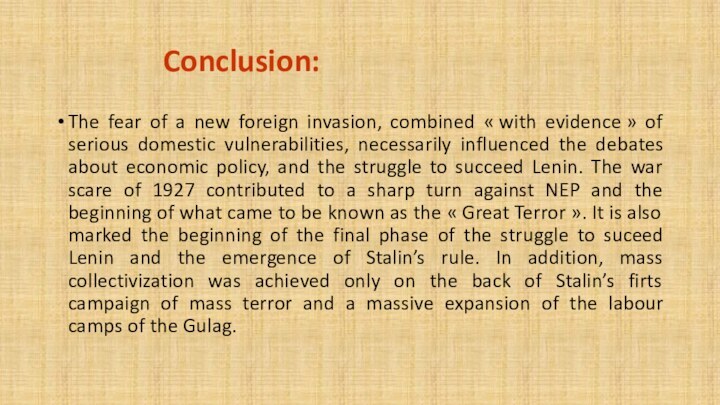


Слайд 2 The comintern and the Western Communist
Parties
1930-1949
Dr. Nikolaos Papadatos- University of Geneva
Слайд 3
The « Great Terror »
THE GREAT PURGES OF THE 1930s
were a maelstrom of political violence that engulfed all
levels of society and all walks of life. Often thought to have begun in 1934 with the assassination of Politburo member Sergei Kirov, the repression first struck former political dissidents in 1935-1936. It then widened and reached its apogee in 1937-1938 with the arrest and imprisonment or execution of a large proportion of the Communist Party Central Committee, the military high command, and the state bureaucracy. Eventually, millions of ordinary Soviet citizens were drawn into the expanding terrorСлайд 4 Debate in the West about the precise numbers
of victims has appeared in the scholarly press for
several years and has been characterized by wide disparity, often of several millions, between high and low estimates. Using census and other data, scholars have put forward conflicting computations of birth, mortality, and arrests in order to calculate levels of famine deaths due to agricultural collectivization (1932-1933), victims of the Great Terror (1936-1939), and total "unnatural" population loss in the Stalin period. Anton Antonov-Ovseenko, Robert Conquest, Steven Rosefielde, and others have posited relatively high estimates.Soviet secret police documents are available that permit us to narrow sharply the range of estimates of victims of the Great Purges. These materials are from the archival records of the Secretariat of GULAG, the Main Camp Administration of the NKVD/MVD (the USSR Ministry of the Interior). We need also take into consideration the State Archive of the Russian Federation (GARF).
Слайд 5
The « Gullags »
THE PENAL SYSTEM ADMINISTERED BY
THE NKVD (Peoples' Commissariat of Internal Affairs) in the
1930s had several components: prisons, labor camps, and labor colonies, as well as "special settlements" and various types of non-custodial supervision. Generally speaking, the first stop for an arrested person was a prison, where an investigation and interrogation led to conviction or, more rarely, release. After sentencing, most victims were sent to one of the labor camps or colonies to serve their terms. In December 1940, the jails of the USSR had a theoretical prescribed capacity of 234,000, although they then held twice that number.Слайд 6 We find also a system of labor camps.
These were the terrible "hard regime" camps populated by
dangerous common criminals, those important "politicals" the regime consigned to severe punishment, and, as a rule, by other people sentenced to more than three years of detention. On March 1, 1940, at the end of the Great Purges, there were 53 corrective labor camps (Исправи́тельно-трудово́й ла́герь (ИТЛ)) of the GULAG system holding some 1.3 million inmates. BAMLAG, the largest camp in the period under review, held more than 260,000 inmates at the beginning of 1939, and SEVVOSTLAG (the notorious Kolyma complex) some 138,000.There was the network of "special resettlements." In the 1930s, these areas were populated largely by peasant families deported from the central districts as "kulaks" (well-to-do peasants) during the forced collectivization of the early 1930s. There was a system of non-custodial "corrective work" (исправительно трудовые работы), which included various penalties and fines.
Слайд 7
The « Great Terror »: The Moscow trials
In March 1938,
the veteran Bolshevik revolutionaries Nikolai Bukharin, Nikolai Krestinsky, Christian
Rakovsky, Aleksei Rykov and Stalin’s former secret police chief Genrikh Yagoda sat with 16 other defendants in the dock in Moscow’s October Hall before Stalin’s hanging judge Andrei Vyshinsky. Charged with a variety of heinous crimes and having been subjected to months of harsh treatment at the hands of the secret police interrogators, they were harangued by Vyshinsky, found guilty, and sentenced to death or long-term imprisonment, which amounted to the same thing. This was the third of a series of major show trials, the first of which, somewhat ironically, had been held under the auspices of Yagoda. The first was held in August 1936, and resulted in Grigori Zinoviev, Lev Kamenev and 14 other Old Bolsheviks being sentenced to death. The second, held in January 1937, resulted in Karl Radek, Yuri Piatakov and 15 others being sentenced to death or long-term imprisonment.Слайд 8 Like a three-ring circus, each trial was
more flamboyant than its predecessor, with increasingly lurid accusations
and confessions about the defendants forming anti-Soviet terrorist groups and for years collaborating with foreign powers and the exiled Trotsky and engaging in terror and sabotage in order to overthrow the Soviet regime and re-establish capitalism, and at the third trial ultimately backdated almost to the October Revolution itself.These three show trials were merely the public face of a far deeper and broader reign of repression. In between the second and third trials, in June 1937, the Soviet government announced that several senior military leaders, including Marshal Mikhail Tukhachevsky, had been found guilty of treason, and had been executed. All the while, the Soviet press was providing long lists of names of officials who had been purged for their alleged involvement in heinous activities against the Soviet state, and plenty more were disappearing without notice.
Слайд 11 The Great Terror followed the tremendous increase in
state coercion and control that accompanied Stalin’s industrialisation and
collectivisation that started in 1929 with the First Five-Year Plan. There had been something of a lull in the level of state repression and official hysteria after the chaotic events of the initial Five-Year Plan had calmed down, and there were widespread hopes that the worst of the upheavals were over. The public image of the Seventeenth Congress was that of party unity having superseded the deep divisions evident at earlier national gatherings.The period from mid-1937 to late 1938, the Ежовщина, was the full-blown Terror, marked most publicly by the Moscow Trials 1936-1938. The Terror affected practically every corner of the Soviet regime. The party’s top and middle cadre, by then mostly loyal to the general Stalinist line, was purged, often with the lower echelons whipping up a witch-hunt atmosphere against them. The military leadership and industrial management structures were particularly badly hit, as were party leaderships in the non-Russian republics, but no government department escaped, and soon nobody at all was safe as the dragnet descended to the rank-and-file worker and peasant. Brutal interrogation resulted in those arrested implicating others, some people denounced others for personal revenge or in the hopes of obtaining their jobs; few indeed could escape suspicion, few knew who to trust. The personal cost was tremendous, Conquest states that ‘the Terror destroyed personal confidence between private citizens everywhere’. Eventually, towards the end of 1938, the Great Terror was reined in.
Слайд 12
The « Great Terror »
The Great Terror of 1937-1938 took
place against the backdrop of war threat. The defendants
of the famous Moscow trials were tried and executed as German, Japanese and Polish spies. When closely examined, the majority of the lesser-known cases, too, show that they were tried as cases of foreign espionage, defeatism and other similar charges related to war and foreign threat. Yet when war is discussed in scholarly literature, it focuses almost exclusively on Germany with whom the Soviet Union did fight a long and bitter war.This is understandable, given that wars with Poland and Japan were much more limited: the September 1939 war with Poland was one-sided and swift with Poland easily dismembered; and the August 1945 war against Japan/Manchukuo was equally one-sided and swift with Japan decisively defeated. Yet, surprisingly the numbers of repressed at the time of the Great Terror as Polish and Japanese spies and agents far surpassed those repressed as German spies and agents. The NKVD statistics show that in 1937-1938, 101,965 people were arrested as Polish spies, 52,906 as Japanese spies and 39,300 as German spies to be followed by Latvian, Finnish, Estonian, Romanian, Greek and other “spies.”
Слайд 13 All major countries (Germany, Poland, Japan, Britain, France
and others) engaged in espionage against the Soviet Union
just as the Soviet Union engaged in espionage against these countries, so why were Poland and Japan more intensely targeted than Germany?According to Stalin, spying did not necessarily consist of placing secret agents in foreign countries: it also consisted of such mundane tasks as the clipping of newspapers. By this logic, nearly every newspaper reader could be considered a foreign spy. Not merely reading but entertaining a certain thought was tantamount to spying, according to L.M. Kaganovich who said in December 1936, “If they stand for [the] defeat [of the Soviet Union], it’s clear that they are spies.”
He said in May 1937, “From the point of view of intelligence, we cannot have friends: there are clear enemies and there are potential enemies. So we cannot reveal any secrets to anyone.” By contrast, Poland and Japan exchanged intelligence and appeared to trust one another. They therefore must have appeared all the more dangerous to Stalin.
Слайд 14 Most if not all those repressed as Polish
“spies” were arrested according to the “Polish Operation” (NKVD
Order No. 00485, dated 11 August 1937). Most are believed to have been arrested in connection with the wholesale deportation of ethnic Koreans from the Far East based on the 21 August 1937 resolution of the government and the party, the “Kharbintsy Operation” (NKVD Order No. 00593 dated 20 September 1937), an operation directed against the former employees (and their families) of the Chinese Eastern Railway (sold to Manchukuo in 1935 and on the basis of NKVD Order No. 52691 dated 22 December 1937 on the arrest of politically suspect ethnic Chinese.Also, Polish and Japanese “spies” were arrested according to other special operations, particularly NKVD Order No. 00693 dated 23 October 1937 (which mandated the arrest of all people who had defected to the Soviet Union by crossing international borders, regardless of the motives and circumstances of their defections and NKVD Order No. 00698 dated 28 October 1937 (to “arrest all Soviet citizens who are connected to the staff of foreign diplomatic offices and who visit their businesses and private premises” and to “place under constant surveillance all members of the German, Japanese, Polish and Italian embassies”).
Слайд 15 In August 1931, Stalin urged M.M. Litvinov, the
Soviet Commissar of Foreign Affairs, not to “yield to
so called ‘public opinion’” (“the common, narrow-minded mania of ‘anti-Polonism’” and to proceed to conclude a non-aggression treaty with Poland.Indeed in 1932, with the tension mounting in the east dramatically owing to Japan’s invasion of Manchuria in September 1931, Stalin succeeded in concluding non-aggression pacts with Poland. (Stalin concluded similar treaties with France, Estonia, Latvia and Finland at the time.).
As for Japan, it is known that Stalin considered the territorial loss in the 1904- 1905 Russo-Japanese War a national insult. Very fond of listening to the music “On the Hills of Manchuria” by I.A. Shatrov (the lyrics of which by S. Petrov includes lines such as “You fell for Rus, perished for Fatherland, / Believe us, we shall avenge you / And celebrate a bloody wake”), he appeared bent on taking revenge.
The « Great Terror » and nationalities:
Слайд 16
Stalin wrote in 1945:
“The defeat of the Russian
forces in 1904 during the Russo-Japanese war left painful
memories in the people’s consciousness. It left a black stain on our country. Our people waited, believing that the day would come when Japan would be beaten and the stain eliminated. We, the people of an older generation, have waited forty years for this day. And now this day has come”.In 1931 Stalin gave a speech about Russian history as a history of “continual beatings owing to backwardness,” beatings by the Mongol khans, the Swedish feudal lords, the Polish-Lithuanian pans, the Anglo-French capitalists and the Japanese barons.
In 1937, anti-Japanese sentiment was such that when, out of diplomatic concern, Litvinov refused to sanction the arrest of a Japanese citizen on the island of Sakhalin, he had to qualify his refusal: “It is perfectly reasonable to suspect that all Japanese in the USSR are spies without exception.”
Слайд 17
In order to carry out the Polish Operation,
A.I. Uspenskii, the head of the Ukrainian secret police
even stated in 1938 that “all Germans and Poles living in Ukraine are spies and saboteurs.”Nevertheless, Stalin’s anti-Polonism and other national prejudices did not play a central causal role in the Great Terror. As is seen in the case of Japan, it was state interests that guided Stalin. According to the US President Harry Truman, Stalin said, “it would be incorrect to be guided by injuries or feelings of retribution”: such feelings are “poor advisers in politics.”
In 1945, Stalin told the visiting Czechoslovaks:
“I hate the Germans, but hatred must not hinder us from objectively assessing them. The Germans are a great people, very good technical people and organisers. Good, innately brave soldiers. It’s impossible to eliminate them. They’ll stay”.
Слайд 18
Stalin also often praised Poland as a “good
nation” and the Poles as brave fighters, the third
most “dogged” soldiers after the Russians and Germans. Ethnic and national prejudices may have played an auxiliary role and aggravated the Great Terror, but it can be assumed that it did not play a central causal role.Слайд 19 Before Adolf Hitler’s ascension to power, Poland and
Japan presented the greatest threat to the Soviet Union.
Until then Germany and the Soviet Union, both inimical to the Versailles settlement after World War I, maintained a degree of amicable relations and even engaged in secret military collaboration. By contrast, Poland and Japan appeared politically and militarily hostile to the Soviet Union. According to Karl Radek, in the early 1930s Stalin feared a simultaneous Japanese-Polish attack.Poland considered the Soviet Union, along with Germany, the greatest threat to its hard-won independence while Japan regarded the Soviet Union, along with the USA, as the greatest obstacle to its imperialist ambitions. In other words, the Soviet Union was a hypothetical enemy for both Poland and Japan, and they acted accordingly. The Soviet Union responded in kind. The two sides actively spied on each other. In this triangular relationship, Poland and Japan found common ground and cooperated, a cooperation that dates back to the 1904-1905 Russo-Japanese War.
The problem of Intelligence :
Слайд 20 In 1923 Japan invited the Polish specialist of
Russian/Soviet cyphers Jan Kowalewski to train Japanese military cypher
specialists. In its war against the Bolshevik Government in 1919-1920 Poland had put its expertise in signal intelligence to good use in defeating its enemies. Poland and Japan continued to exchange intelligence concerning the Soviet Union throughout the 1920s, the 1930s and even during WWII when they were technically at war.In both Poland and Japan, not all politicians and military leaders considered Soviet Union the most dangerous potential enemy. In Poland, opinions split as to which posed the greater danger, Germany or the Soviet Union. Similarly, in Japan, there was a split in assessing the relative danger of the USSR and the USA. Nevertheless, neither country neglected anti-Soviet intelligence after the Russian Civil War ended and diplomatic relations had been established with the Soviet Union.
Слайд 21 Much of Poland’s anti-Soviet intelligence was carried out
by the Dwójka, the Second Department of the General
(later Chief) Staff of the Polish Army. Poland was well situated to carry out anti-Soviet intelligence, because many of the citizens of the newly independent state were former citizens of the Russian Empire, intimately familiar with the way of life in Russia, Ukraine and Belarus.The pre-history of this action: Soviet leaders were also convinced that Britain and France stood financially and military behind the polish forces that attacked Bolshevik Russia in the Spring of 1920. (RGASPI: 588/11/1180, f.53). When the campaign suddenly went badly wrong for the poles and soviet forces were on the outskirts of Warsaw, a contingent of French military advices under General Maxim Weygand helped chase the Red Army out of Poland. After a peace was negotiated, the Bolsheviks watched carefully as the French continued to contribute money and arms to the polish and Romanian armies. (Pravda, 18.12.1921). For France, close ties with strong and stable regimes in eastern and southern Europe was a critical part of her strategy to contain Germany. Soviet leaders continued nevertheless to see the diplomatic and military ties among Britain, France, the Balkan states, Romania, Poland, the Baltic states, and Finland as evidence of a long-term plan to prepare a new assault on them.
Слайд 22 This sort of caution was sensible, given that
these countries had given refuge to the bulk of
the white armies as they retreated from Russia. Soviet intelligence agencies warned that these states created the hundreds of thousands of the white soldiers in arms and ready for war. (Maxim Litvinov’s correspondence with the Politburo, RGASPI: 359/1/3).In November 1925, Dzerzhinski passed to Stalin reports to the effect that Britain was trying to promote a deal that would end the trade war between Poland and Germany and resolve tensions over disputed borders. (RGASPI: 76/3/364, ff. 23-31).
Слайд 23 A few months later, he reported that the
British were canvassing Whites in Prague, Paris and Constatinople
on the possibility of cooperation in an invasion of the USSR. Later, Stalin was told that the Japanese might join the coalition, supported by Zhang Zuolin in China. (RGASPI: 76/3/362, f.3). The “coalition” was apparently already increasing subversion and espionage in soviet borderlands in anticipation of military action.Iagoda (Генрих Григорьевич Ягoда), one of the main leaders of the Soviet state security bodies (the Cheka, the GPU, the OGPU, the NKVD), the People's Commissar for Internal Affairs of the USSR (1934-1936), the first ever "General Commissioner of State Security“, stated on 14.04.1926: “Materials in our possession which confirm beyond doubt that on the instructions of the English, the Polish and other general Staffs of countries on our western borders have begun broad subversive work against the USSR and have increased their espionage network on our territory… Measures are being taken…”.
Слайд 24 In early July 1926, Дзержинский wrote to Stalin
asserting that “there is an accumulation of evidence which
indicates with doubtless (for me) clarity that Poland is preparing a military assault on us with the goal of seizing Byelorussia and Ukraine. (RGASPI: 73/3/364, f. 58).Throughout 1920, the intelligence services had warned that foreign governments were building networks of agents within the USSR whose task was to undermine soviet power from within by means of the sabotage of factories and infrastructure, the assassination of officials, and the organization of a fifth column in the event of war.
Taking the above into account, in 1937 there were more than 636,000 ethnic Poles in the Soviet Union, about seventy percent of them in Ukraine, on whose service Poland expected to draw. During WWI Piłsudski, the future leader of Poland, had founded a secret military organisation (Polska Organizacja Wojskowa, POW) for the purpose of intelligence and subversion against Poland’s enemies (Russia, later Soviet Russia, and Germany). Although it ceased to exist after the Polish-Soviet War of 1919- 1920, the Dwójka absorbed many of its members, inherited its expertise and sought to utilise the remnants of its conspiratorial organisational structures in the Soviet Union.
Слайд 25 An example: Jerzy Niezbrzycki (Ryszard Wraga), a native
of Ukraine and a former citizen of the Russian
Empire who spoke Russian and Ukrainian in addition to Polish, had been a member of POW and had fought in the Polish-Soviet War. From 1927-1929 he worked as an intelligence operator under the guise of a diplomat at the Polish Consulates in Kharkiv and Kyiv from where in December 1929 he was expelled on charges of espionage. In 1932 Niezbrzycki was appointed the head of the Dwójka’s “Eastern Section” (in charge of the Soviet Union), where he worked until 1937.As Niezbrzycki’s case suggests, Poland, probably like many other countries and certainly Japan and the Soviet Union, used diplomatic missions extensively to cover its intelligence activity. Until 1937 Poland maintained consulates in Moscow, Leningrad, Kharkiv, Kyiv, Minsk and Tiflis where they ran intelligence operations. Diplomatic posts in other key countries, particularly those surrounding the Soviet Union such as Japan, Finland, Turkey, Latvia, Estonia and Czechoslovakia as well as Germany, France and Yugoslavia served the same purpose.
Слайд 26 One of the most important strategic goals of
independent Poland was to weaken and, if possible, destroy
the Soviet Union and for this purpose Poland sought to encourage the separatist movements of national minorities in the Soviet Union. In the 1920s and 1930s Poland operated the “Promethean Movement,” an “anticommunist international, designed to destroy the Soviet Union and to create independent states from its republics.As Timothy Sander states: “It brought together grand strategists of Warsaw and exiled patriots [Ukrainians, Georgians, Azeris, and others] whose attempts to found independent states had been thwarted by the Bolsheviks [and was] supported by European powers hostile to the Soviet Union, morally by Britain and France, politically and financially by Poland”. (Timothy Snyder, Sketches from a Secret War: A Polish Artist’s Mission to Liberate Soviet Ukraine (New Haven, CT: Yale University Press, 2005), 40).
Слайд 27 The most important group for the “Promethean movement”
was Ukraine. Poland contained a large Ukrainian minority, many
of whom were Ukrainian nationalists and irredentists with Soviet Ukraine. Just as many of these Ukrainian nationalists considered Communist Russia to be their enemy (occupier of Easter [Soviet] Ukraine), so too did they regard Poland as enemy (occupier of “Eastern Galicia” or “Western Ukraine”). It was vital for Poland to divert their attention and political energy away from Poland towards the Soviet Union. Even though the Ukrainian nationalists engaged in political terror against Polish authorities, Poland tolerated their presence in the country and allowed and even encouraged their anti-Soviet activity. An unknown number of them are believed to have acted as Polish agents as well. An incident that took place in the spring of 1932 is characteristic.Слайд 28 In May of that year, according to an
Japanese record intercepted by Soviet spies:
“the Japanese military attaché
in Moscow, Torashirō Kawabe, enquired of his colleague in Warsaw, Hikosaburō Hata, whether the rumour he had heard in Moscow that two members of the Polish General Staff were executed for, espionage for the Soviet Union was true. Two days later, Hata, who worked closely with the Polish intelligence agency, responded: the Polish General Staff recently sent 20-odd secret agents to Ukraine, all of whom, however, were caught by the GPU. Two “secretaries” of the General Staff had been bought off by the Soviets and leaked secret information to them. They were court-marshaled and sentenced to be shot. The Kawabe-Hata correspondence was intercepted by the Soviet secret police and reported to Stalin”. Слайд 29 According to Soviet data, between 1922 and 1936,
the Soviet Ukrainian border guards arrested 1,763 “spies,” 66
“diversionary elements” and 5,326 “smugglers” (of whom 479 were armed). The Soviet data also indicate that there were 144 cases of armed conflict with border transgressors from Poland, as a result of which 60 “bandit groups” (both local and foreign) were “liquidated.” Likewise, between 1921 and 1935 the Soviet Belarusian border guards apprehended 4,902 “spies,” 550 “diversionary elements” and 13,656 “smugglers.” 282 cases of armed conflict were also recorded. Needless to say, Poland feared that many bordercrossers from the Soviet Union were Soviet spies. For what appears to be in the first few years of the 1930s, Poland, according to Japanese sources, captured 1,500 “Soviet spies” along its borders with the Soviet Union.Слайд 30 Likewise, many Ukrainian émigré organizations in Poland and
elsewhere were penetrated by Soviet agents. The penetration was
mandated especially after the assassination in October 1933 in L´viv of the Soviet secret police agent working under the cover of Assistant Consul, Andrei Mailov, by the OUN (Organisation of Ukrainian Nationalists) terrorist Mykola Lemyk. The most famous example is the master Soviet spy Pavel Sudoplatov, who penetrated the OUN and succeeded in assassinating its head, Ievhen Konovalets, in Rotterdam in May 1938. As it turned out, the OUN division in Finland was led by the Soviet agent K. Poluved´ko.Both Poland and the Soviet Union acknowledged that they spied on each other. On a number of occasions in the 1920s and 1930s, the countries exchanged political prisoners (including spies), the last in 1936.
Слайд 31 By the mid-1930s, like ethnic Germans, ethnic Poles
in the Soviet Union were probably subjected to detailed
census. In 1931-1933 the Soviet secret police used its agents and informers, particularly teachers at Polish schools, to investigate the households of ethnic Poles under the guise of teachers’ visits. They informed the police on the Polish household’s political orientations, on whether they retained connections with Polish diplomatic missions and other sensitive matters such as their attitudes towards the collectivization of agriculture.Shortly after the December 1934 murder of Sergei Kirov in Leningrad, Moscow began to deport ethnic Poles, Germans and Finns as well as other politically suspect from its border zones.
Слайд 32 Like other countries, Japan used its diplomatic posts
for intelligence. Not merely its missions in the Soviet
Union but in those countries surrounding the Soviet Union, particularly Finland, Sweden, Poland and Turkey, were used for this purpose. Japan’s intelligence activity increased sharply after the Manchurian invasion (18 September 1931). Remarkably, from 1931 Japan stationed a full-time military attaché in the three small Baltic states (the attaché in Latvia served as the attaché in Estonia and Lithuania) and collaborated with Baltic intelligence services against the Soviet Union. From 1932 an intelligence officer was attached as a consular official to the Japanese consulates in Vladivostok, Khabarovsk, Novosibirsk and the Manchukuo consulate in Chita, and from 1934 in Blagoveshchensk (Manchukuo) and in Odessa as well. From 1933, Japan began to post a military attaché to its legation in Tehran, Persia (Iran from 1935). In 1936 Japan set up the office of military attaché in Afganistan, but the Japanese officer was promptly expelled for espionage in 1937.Слайд 33 Like Poland, Japan showed keen interest in the
minorities within the Soviet Union whose independence movements could
be utilized for political and military purposes. Among the tens of thousands of émigré “Russians” in Manchuria were numerous ethnic Ukrainians and Poles. In certain districts in the Vladivostok area ethnic Ukrainians accounted for more than half of the population. There were Chinese, Koreans, Tungusic people (such as Manchus, Oroqens or Orochons), Mongols (Buriat) and other ethnic groups on both sides of the Soviet-Manchu (Japanese) borders. Japan used all these people for intelligence in Manchuria, Sakhalin and elsewhere in the Far East.Some documents related to Japan’s espionage against the Soviet Union presumably lost in WWII later surfaced in Soviet hands and copies were submitted at the Tokyo Trial as evidence of Japan’s anti-Soviet machinations. Japan targeted Trotsky supporters inside and outside the Soviet Union for possible agents. In 1931-1932, the Japanese military attaché in Warsaw Hikosaburō Hata worked closely with émigré Muslim leaders against the Soviet Union.
Слайд 34 Japan and Poland had common political and military
interests and worked closely. In any case, the Soviet
Union suspected that the two countries had signed a secret agreement in the autumn of 1931 whereby Poland was obliged to deflect the Soviet forces upon itself when Japan began to advance its troops against the Soviet Union. This intelligence report, acquired by a Soviet agent in Poland, was sent to Stalin in March 1932. (RGASPI: 558/11/185, f. 1-65).The Soviet secret police also penetrated the office of the military attaché in the Japanese Embassy. In December 1931 and February 1932 two stolen memoranda from the embassy were circulated among the Politburo members. In one of them dated 19 December 1931, that is after Japan’s conquest of Manchuria, the Japanese Ambassador in Moscow Kōki Hirota was quoted as having conveyed the following opinion to the Japanese General Staff in Tokyo:
“On the question of whether Japan should declare war on the Soviet Union — I deem it necessary that Japan be ready to declare war at any moment and to adopt a tough policy towards the Soviet Union. The cardinal objective of this war must lie not so much in protecting Japan from Communism as in seizing the Soviet Far East and Eastern Siberia”. (N. Khaustov, V.P. Naumov, N.S. Plotnikova, Lubianka: Stalin i VChK-GPU-OGPUNKVD. Ianvar´ 1922-dekabr´ 1936 [The Lubianka: Stalin and VchK-GPU-NKVD, January 1922-December 1936] (M.: Mezhdunarodnyi fond demokratsii, 2003, 292, 295).
Слайд 35 After the Polish-German non-aggression pact signed in January
1934 and Poland’s opposition to the entry of the
Soviet Union into the League of Nations, Soviet-Polish relations deteriorated (even though the two countries had renewed the 1932 Polish-Soviet non-aggression treaty for ten years in 1934).The Soviet Union increased its subversion against Poland and its military by using Comintern agents and Communists. The tension in the east led to the “Great Terror” in Mongolia, engineered by Stalin in 1937. On 27 November 1934 the Soviet Union concluded a treaty of mutual military assistance with Mongolia. On 12 March 1936 the Soviet Union and Mongolia renewed their treaty of mutual aid for ten years. In the mean time Japan/Manchukuo and Mongolia had a number of border clashes. Manchukuo and Mongolia held meetings to resolve the border issues. When it was announced on 25 November 1936 that Germany and Japan had signed an agreement (Anti-Comintern Pact), the Mongolian delegation left the negotiation table.
The Terror of the soviet state:
Слайд 36 Meanwhile, the NKVD, now headed by Nikolai Ezhov,
reassessed its foreign intelligence. It had so successfully penetrated
the émigré anti-Soviet organizations that by 1937-1938 the NKVD no longer considered it important to uncover these organizations “diversionary, terroristic and espionage” activity in the Soviet Union. R.N. Baiguzin, ed., Gosudarstvennaia bezopasnost´ Rossii: Istoriia i sovremennost´ [State Security in Russia: History and the Present] (M.: ROSSPEN, 2004), 491, 523-524 (V.N. Khaustov).The secret police became alarmingly concerned about the penetration of Soviet organizations by foreign intelligence. Ezhov entertained deep suspicion of his predecessor’s (Iagoda’s) foreign operatives. It is also true that the Soviet Union used fake deserters extensively to penetrate foreign countries: the secret police used its agents as convinced anti- Soviet defectors to fool foreign intelligence.
Слайд 37
Alexander Orlov, a former NKVD official noted that:
“Stalin
used to say: “An intelligence hypothesis may become your
hobby horse on which you will ride straight into a self-made trap… Don’t tell me what you think, give me the facts and the sources!”. (Alexander Orlov, Handbook of Intelligence and Guerrilla Warfare (Ann Arbor, MI: University of Michigan Press, 1963), 10.).Late in his life, Molotov told his interviewer that every day he used to spend half a day reading intelligence reports, but insisted that it was impossible to rely on spies, who “could push you into such a dangerous position that you would never get out of it”: “You have to listen to them, but you also have to verify their information.” In June 1937, Stalin contended that in all spheres but one, the Soviet government had defeated the international bourgeoisie, which, however, had beaten the Soviet government effortlessly in the area of intelligence operations.
Слайд 38 The Great Terror was a precautionary strike against
people who could pose internal threat in the event
of war. Stalin was extraordinarily cautious. Believing that one spy could determine the outcome of war, he left nothing to chance. He believed that if only 5 percent of the alleged enemies were enemies, it was a big deal (если будет правда хотя бы на 5%, то и это хлеб ) - His 2 June 1937 speech in Istochnik, no. 3 (1994): 79-80.According to Nikita Khrushchev, Stalin believed that “Ten percent of the truth is still the truth. It requires decisive action on our part, and we will pay for it if we don’t act accordingly”.
There is much evidence that Stalin believed in the ninety percent of the truth, but used the ten remaining percent for his political purposes.
Слайд 39 In October 1938, when he was ending the
Great Terror, Stalin stated that Bukharin had had “ten,
fifteen, twenty thousand” supporters, and that there were as many, possibly more, Trotskyites. As Stalin said:“Well, were they all spies? Of course, not. Whatever happened to them? They were cadres who could not stomach the sharp turn toward collective farms and could not make sense of this turn, because they were not trained politically, did not know the laws of social development, the laws of economic development, the laws of political development. […]How to explain that some of them became spies and intelligence agents? […] It turns out that they were not well-grounded politically and not well grounded theoretically. They turned out to be people who did not know the laws of political development, and therefore they could not stomach the sharp turn”.
Слайд 40 The Stalinist violence of the years 1937-1938 was
inextricably linked with the effort of political, economic and
military stabilization of the Soviet regime in extremely unfavorable international conditions. Within a tense international environment, the new indispensable funds for industrialization would be borne by the private sector, primarily by imposing a new tax system on villagers, creating a heavy industry which, based on a planned plan, would lead, as hoped by its initiators, to lower prices of all small and medium-sized industry products. The main hypothesis was: the peasants were about to participate voluntarily through consensus in the plan. (Госплан СССР (Государственный плановый комитет Совета Министров СССР)).
Interpretation of the « Great Terror »:
Слайд 41 According to Stalin, the critical state of the
rural economy, expression of which was the last failed
harvest of 1928-1929, was due to the rich (Кулак) and other hostile forces who “where ready to undermine the Soviet regime”. The mass exile of villagers to the inhospitable provinces of the Soviet Far East was largely driven by the above Stalinist assumption of reality and by the need to exploit the "virgin" natural resources of the USSR.Under these conditions, the Soviet state decided to “declare war” to the kulaks. On January 30, 1930, under a secret decision of the политбюро,Генрих Ягода, генеральный комиссар государственной безопасности, addressed all Regional Chiefs of NKVD, forwarded the decree “44-21” which listed "the measures to clear the “kulaks as a class”.
Слайд 42 On July 30, 1937, the Secret Police (NKVD)
issued the decree No 00447 on the 'mass suppression
of kulaks'. It is the operation with the largest number of victims - 767,000 arrested, of whom approximately 387,000 were executed - during the mass deportations and liquidations of the period 1937-1938. This particular order, bearing the signature of Nikolai Yezov, was targeting in particular the following social groups:Former kulaks who had already been convicted, returned to their homes and continued to commit "anti-Soviet activity".
'Socially damaging elements' and former kulaks who had criminal or anti-Soviet organization.
Former members of various parties except the Bolsheviks (Mensheviks, left-wingers, etc.).
Слайд 43 Anti-Soviet elements that actively collaborated with religious- criminals,
former kulaks, "White" and members of the clergy who
were already doomed, imprisoned or executed.Anti-Soviet elements that had served in various formations Cossacks, "White" or other clerical anti-Soviet groups.
Terrorists (criminals, bandits, aliens, counterfeiters, of agricultural production ") who continued to maintain relations with the world of crime and had either been convicted or was about to be committed in trial.
All of the above "harmful social groups" were classified into two major categories: the "most active anti-Soviet elements" constituted the category I and "less active" category II. The first should be arrested without delay after the expiry of the expedition evaluation by a three-member committee (troika) and then where executed. The second category consisted of persons who were arrested and placed in concentration camps in order to serve a sentence of 8 or 10 years.
Слайд 44 The second largest purge was named “national operation”.
The “national operations” of 1937 and 1938 consisted of
individual “national operations” such as the “German national operation”, “the Polish national operation”, the Latvian national operation”, “the Finnish national operation”, “the Greek national operation”, “the Estonian national operation”, etc. - which were directed against the political minorities of the above countries whi had migrated to the USSR.Also, these repressive operations were targeting Soviet citizens of German, Polish, Finnish, Greek origin etc., or Soviet citizens who maintained or had just concluded family and business relationships in the past with a certain number of countries that were characterized as hostile by Moscow. More specifically, immigrants or Soviet citizens (of non-Russian origin) who faced neighboring states such as Poland, Germany, Romania, Japan and the Baltic countries faced a particular problem.
Слайд 45 On July 20, 1937, Stalin notified the NKVD
leadership of the following directive: "You capture all provinces
of all Germans who work in military, partly military, chemical plants, as well as those working in power plants or other ones under construction." These instructions were further codified in Order No 00439, which was sent by Yezhov to all NKVD regional governors.The basic argument was, according to the directive, that "the German Army General Staff and Gestapo had put in place a huge wave of espionage and sabotage, targeting mainly the national defense industries, the railways and other strategic industrial sectors" of the USSR.
The administrative-police logic of arrests remained the same. There were two main categories of arrestees, the first one being directly executed and the second being imprisoned for 8-10 years. For the "German national enterprise", "56,787 people were arrested, of which 41,898 were executed and 13,107 were imprisoned”.
Слайд 46
Komintern and the Purges
According to Stalin’s speech
(7th November 1937):
“I want to say a few words,
maybe not festive. Russian tsars did a lot of bad things. They plundered and enslaved people. They waged wars and seized territories in the interests of the landlords. But they did one good thing - they built a huge State - to Kamchatka. We inherited this State. And for the first time, We Bolsheviks, rallied and strengthened this State as a single, indivisible State, not in the interests of the landowners and capitalists, but in favor of the working people, all the nations making up this State. We united the State in such a way that every part that would be divorced from the common socialist state, would not only damage the latter, but could not exist on its own and would inevitably fall into another's bondage. Therefore, anyone who tries to destroy this unity of the socialist state, who aspires to separate from him a separate part and nationality, he is an enemy, sworn enemy of the State of the Peoples of the USSR. And We destroy every such enemy, even if he is an old Bolshevik, we will destroy all his clan, his family. Everyone who, with his actions and thoughts, and with his thoughts, encroaches on the unity of the socialist state, we will relentlessly destroy. For the destruction of all enemies to the end, their own, their clan!”.Слайд 47 “Letter from Dimitrov and D.Z. Manuilsky to the
Central Committee of the CPSU
To Yezhov, Zhadanov, Andreev,
Recently, the
organs of the People's Commissariat for Foreign Affairs have revealed a number of enemies of the people and a ramified spy organization in the apparatus of the Comintern. Particularly infiltrated was the Vashnevsky department of the Comintern - the communications service, which must now be completely eliminated and to proceed urgently to organize a new department composed by new comprehensively selected and tested guards.. Although a number of the other sections of the Comintern's apparatus were also infiltrated: the personnel department, political assistants to secretaries of the ECCI, referents, translations, etc.In addition, the leadership of the Comintern was carrying out the work of testing the whole apparatus, as a result of which about one hundred people were dismissed, like persons who did not inspire sufficient political trust.
Слайд 48 In the past, the Comintern's apparatus was staffed
mainly by cadres of foreign communist parties, especially by
illegal Communist Parties with large emigrant reserves in the USSR. Experience has shown that such a method of staffing the Comintern in the Present Conditions is dangerous and harmful, because a number of sections of the CI, such as the Polish one, have been wholly in the hands of the enemy.Therefore, we will not get out of a difficult breakthrough without the assistance of the Central Committee of the ВКП (б), the application for which we submitted to Comrade Malenkov. The assistance of the Central Committee of the CPSU is an especially urgent matter now and is hastily required on the staffing of the communications service, because the suspension of its work cut us off completely from abroad.
Proceeding from this, we are requesting the Politburo's resolution on the urgent satisfaction of our application, sent to Comrade. Malenkov”. (RGASPI, 495/73/50, FF. 25, 26).
Слайд 49
Conclusion:
The fear of a new foreign invasion, combined
« with evidence » of serious domestic vulnerabilities, necessarily influenced the
debates about economic policy, and the struggle to succeed Lenin. The war scare of 1927 contributed to a sharp turn against NEP and the beginning of what came to be known as the « Great Terror ». It is also marked the beginning of the final phase of the struggle to suceed Lenin and the emergence of Stalin’s rule. In addition, mass collectivization was achieved only on the back of Stalin’s firts campaign of mass terror and a massive expansion of the labour camps of the Gulag.Слайд 50 The international situation appeared only to got worse,
first with the Japanese invasion of Manchuria in 1931
deepening the sense of an encirclement of hostile capitalist partners. Then the Anti-Comintern pact in 1935 and the subsequent Spanish Civil War confirmed for Stalin that the anti-Soviet coalition of the most reactionary capitalist states had come into the open and the “hot” war had begun.In the context of Russian civil war, Lenin had employed the political police against organized and active enemies of the new regime. Between Lenin’s death and the middle of the 1930’s the experience of the civil war hosted the soviet leadership. Soviet политбюро, Stalin and his close associates, felt that a major threat was in front of them. Their ideology, their understanding of revolution and counter-revolution and their system of information-gathering left them convinced that mortal threats had never receded.









